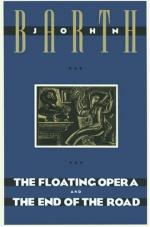|
This section contains 185 words (approx. 1 page at 300 words per page) |

|
The Floating Opera reflects two notable influences: Albert Camus and Machado de Assis. Barth's preoccupation with suicide reflects the influential intellectual climate that inspired Camus's speculations on the same subject. His protagonist — self-conscious and somewhat unreliable — participates in a narrative tradition that stretches back to Laurence Sterne's Tristram Shandy (1759-1767). For example, the chapter entitled "Calliope Music" begins with two columns of print placed side by side on the page.
The left column comments upon the absurd law case that Todd is currently considering, while the right column reveals a rational justification for suicide. Though Todd excuses his device as a symptom of authorial ineptitude, this typographical arrangement demonstrates that when all of the facts relevant to an experience are considered, no single account can be seen as definitive. Barth's immediate source for these narrative devices is to be found in the...
|
This section contains 185 words (approx. 1 page at 300 words per page) |

|




